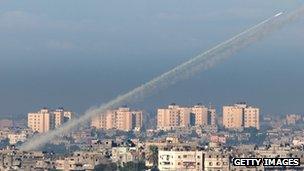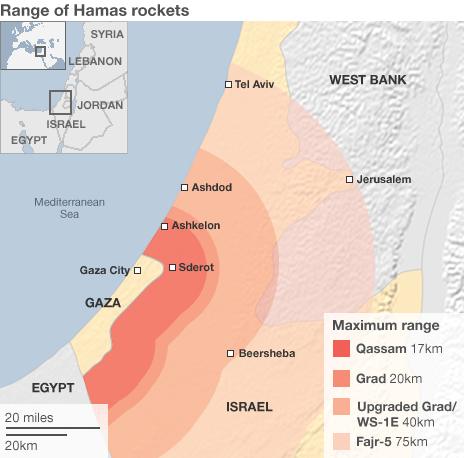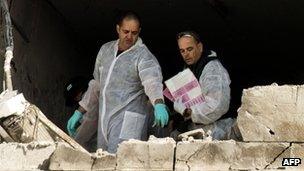Gaza rocket arsenal problem for Israel
- Published

While not especially accurate or sophisticated, Palestinian rockets remain a threat for many Israelis
The upsurge of fighting between Israel and Hamas has highlighted, once again, the total disparity of force between the two sides.
Israeli aircraft and naval units can operate against targets in the Gaza Strip pretty much at will.
If there were to be a major ground incursion by Israel - something that probably both sides would want to avoid - the military balance again would be overwhelmingly in Israel's favour.
Equally though, the fighting has highlighted the pervasive risk posed by the Palestinian rocket arsenal to Israeli citizens living in the southern part of the country.
Palestinian rockets may not be especially sophisticated or accurate.
Nonetheless, they remain a serious threat, as the direct hit on an apartment building in Kiryat Malachi on Thursday morning, which left three dead, demonstrated.
Israeli towns or cities in a broad arc south of Tel Aviv are all potentially within range of these rockets. Hundreds of thousands of Israelis live in their shadow and this is a situation that successive Israeli governments have struggled to deal with.

The Palestinian rocket arsenal is large and gradually improving over time. Many of the shorter-range systems, like the Qassam - a generic name for a whole family of weapons - are built in factories and workshops in the Gaza Strip itself. These have ranges up to a dozen or so kilometres.
'Surgical strikes'
Grad missiles, many thought to be supplied by Iran, have a slightly longer reach - up to about 20km - though some upgraded versions may have a considerably longer range.
A Chinese-designed rocket, the WS-1E, has also been used against Israeli targets - these have a range of around 40km.
The most potent weapons in the Palestinian arsenal are the Fajr-5 rockets. These have a potential range of up to 75km, threatening the fringes of Tel Aviv - Israel's largest city.
Storage sites for these weapons have been among the specific targets sought out by Israeli aircraft.
Israeli military spokesmen claim to have been remarkably successful in destroying them, though there are reports that at least one Fajr-5 has been fired during the current round of fighting.
Israel's response to the missile threat has been both defensive and offensive in nature. Its relatively new anti-missile system - dubbed Iron Dome - is heavily engaged in the current fighting. This has been operational since 2011.
Each of the four available batteries can defend an area the size of a medium-sized town.
Powerful radars identify and track incoming missiles; their likely landing point is estimated and the battery then fires interceptor missiles at those determined to be heading for populated areas.
Ticking clock
Iron Dome appears to be working well in this crisis but no defensive system can be 100% successful.

Hundreds of thousands of Israelis live within range of the rockets
Israel has also sought to disrupt missile consignments heading to the Gaza Strip.
This is especially the case for the longer-range Iranian and Chinese-designed rockets, some of which, analysts believe, come by a complex smuggling network from Iran, to Sudan and then overland through Egypt and the Sinai Peninsula into the Gaza Strip.
The "mystery" air attack against a consignment of shipping containers outside an Iranian-operated arms factory in Sudan in late October is widely seen as having been carried out by the Israeli Air Force in an attempt to interrupt weapons supplies going to Hamas or other Palestinian groups.
Regular air strikes in the Gaza Strip have targeted individual leaders of some of the smaller Palestinian factions, along with crews getting ready to launch rockets.
But this is the largest Israeli operation since its ground incursion into the northern Gaza Strip in 2008-09.
Inevitably, for all the talk from Israeli spokesmen of "surgical strikes", Palestinian civilians have been killed.
Civilian casualties, of course, could rise dramatically if the Israelis move towards a ground offensive. All of the pressures point towards an escalation of the fighting before it dies down.
The outcome may well be another uneasy ceasefire that perhaps could last for some time.
That is clearly what the Israelis want out of this. But the basic dilemmas in the Gaza Strip remain unchanged.
There is no sign of any credible peace process. And, once this crisis ends, the clock may well be ticking towards the next eruption of violence.